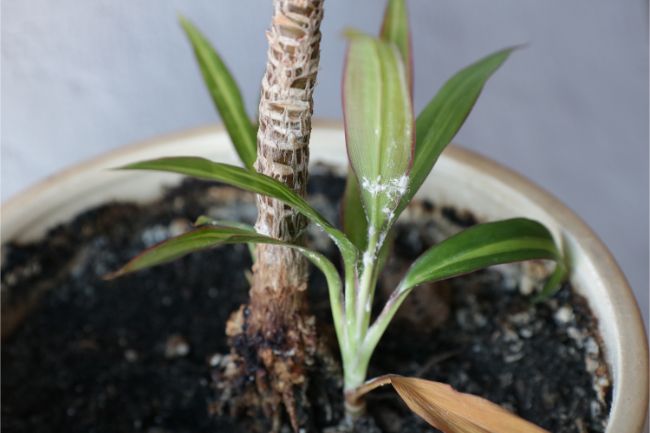Compared to growing plants outside, indoor plants tend to experience fewer problems, making them popular with many homeowners because of their easy maintenance. They are prone to some problems though, and a common concern is whether indoor plants attract bugs?
Do Indoor Plants Attract Bugs?
Yes, indoor plants attract bugs. They are are usually attracted by indoor growing conditions that have high humidity or a lack of air circulation. The most common pests are aphids, spider mites, fungus gnats, mealybugs, scale, thrips, and whitefly.
Maintaining good growing conditions, watering properly, and regularly inspecting your plants will help keep infestations low and allow you to treat them quickly, minimizing damage to your plants.
Chances are if you are reading this you may have some bugs and are searching for information on them. You’re in luck! Keep reading to learn more about why you may have bugs, as well as how to identify, eradicate and prevent them. I’ll also discuss which houseplants are most resistant to pests.
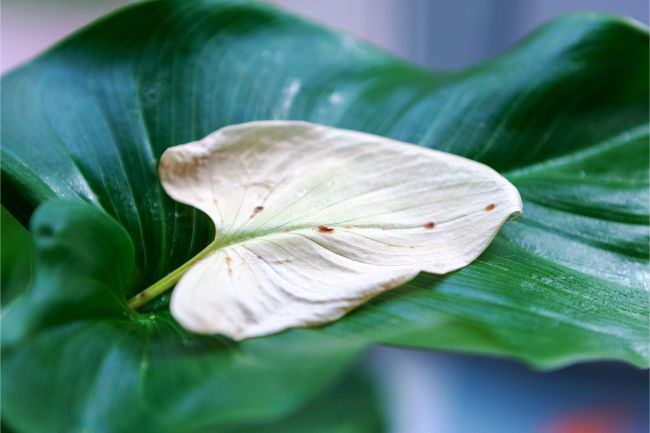
Growing Conditions That Attract Houseplant Pests
Typically problems with bugs arise because of indoor growing conditions that draw them in, with humid, wet conditions being the biggest culprit.
High Humidity Can Attract Pests To Indoor Plants
Many bugs have a knack or sixth sense for flocking towards an area with high humidity. Due to their small body size, they need to keep their bodies moist or they will dry out and die causing them to seek out areas where the moisture levels are higher.
High humidity conditions are usually brought on by the following:
- Climatic conditions: Areas closer to large bodies of water (i.e. the South, the Pacific Northwest, and other coastal areas) or ones that experience higher levels of precipitations have a higher relative humidity level than desert areas such as Arizona, New Mexico, and parts of the Intermountain West. This naturally higher humidity level maintains a higher humidity level within your home.
- Overwatering: Regardless of the climate you reside in, giving your plants too much water or watering too frequently is one of the biggest culprits of high humidity levels immediately surrounding your indoor plants. Overwatered, soggy soils will raise the relative humidity levels around the plant as water evaporates from the soil surface.
- Standing water: This is somewhat related to overwatering but more so in regards to the amount of water you are giving your plant each time. Watering too much at any given time is problematic if you have saucers under your containers to collect the water draining out of your pots.
Lack Of Air Circulation
Air movement around your plants is really important to help keep the humidity level from getting too high, but it also prevents bugs in another few ways. Increase ventilation accelerates drying of the soil, and decreases fungal growth, making your indoor plants a less hospitable place for bugs to live. Lack of air circulation can occur for a couple of different reasons:
- No space: Placing plants too close together is the biggest reason for little air circulation through the foliage. Although grouping your plants, can be useful to increase humidity where needed, try to avoid letting your plants touch each other, as this will decrease ventilation around the foliage.
- No air movement: Some areas of your home may not be close to windows, doors, vents, or receive the gentle air movement created by ceiling fans or people walking by. Move your plants to an area that is better ventilated, leave a window open or consider using an oscillating fan if necessary.
If you’ve got bugs on your houseplants right now, read my article about how to get rid of houseplants naturally. This covers some great options to easily eradicate any bugs on your indoor plants using natural, environmentally friendly treatments.
Common Bugs On Indoor Plants
The variety of insects you find on indoor plants is much less extensive than those you find on outdoor ornamentals and garden plants. When it comes to indoor plants there are less than a dozen bugs that are common nuisances: aphids, spider mites, fungus gnats, mealybugs, scale, thrips, and whitefly.
Aphids
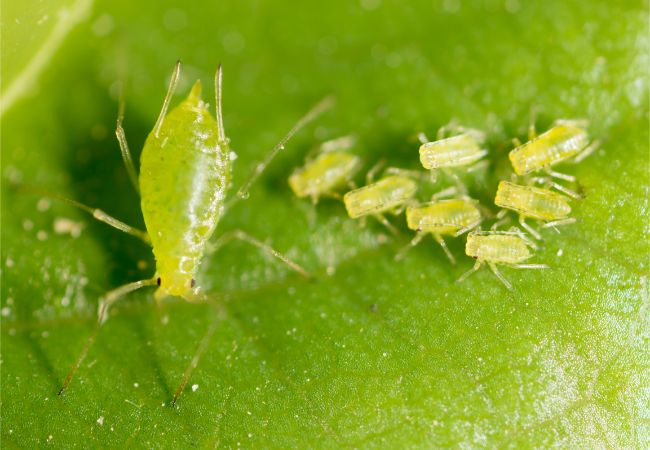
Aphids are tiny, sap sucking insects that love to attach themselves to your houseplants, doing considerable damage to them over time. They secrete honeydew, a sticky, liquid, which can be found on the leaves and stems. Houseplants affected by aphids develop distorted leaves as well as yellowing foliage, which often leads to leaf drop.
One of the biggest challenges with this minute pests is they reproduce prolifically and can become abundant very quickly.
Spider Mites
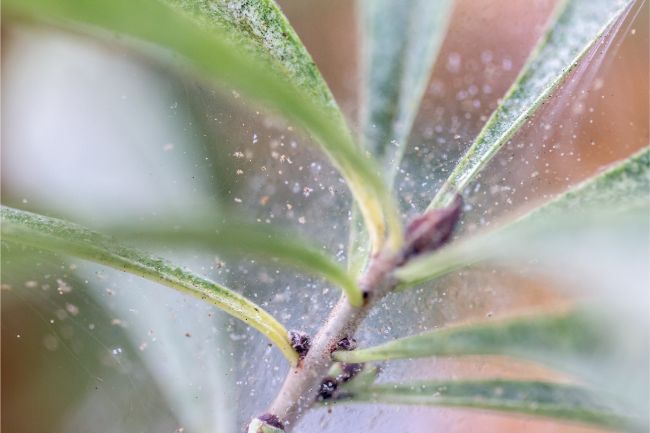
Spider mites can be hard to detect due to their small size. Look for fine webbing between the foliage of your plants and check both sides of the leaves for evidence of these tiny little bugs that are usually less than 1mm wide and come in a variety of colors.
Spider mites pierce the leaves of houseplants to get at the fluid within. Plants affected by spider mites can develop stippled discoloration or generalised leaf yellowing. The earliest sign of a problem is detecting the fine webbing they produce, but you will need to inspect your plants closely to detect them.
Spider mites reproduce rapidly and a large population can develop before being noticed. Often, it is the physical change in the appearance of the plant which prompts plant owners to inspect and detect these houseplant bugs. Learn everything you need to know to get rid of spider mites in this article.
Fungus Gnats
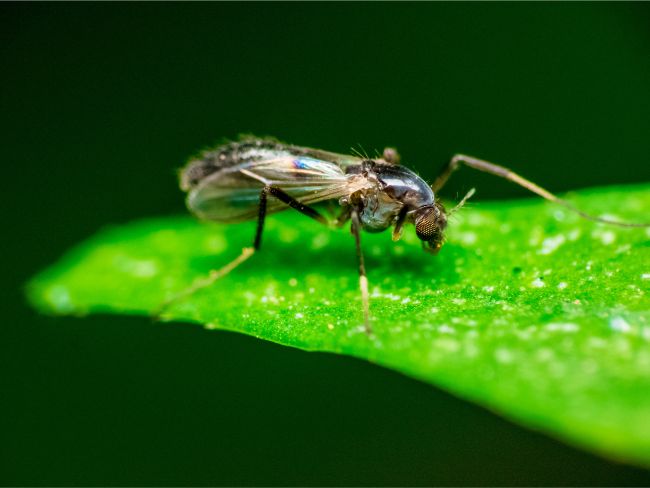
Fungus gnats are a nuisance, and while the damage they do to plants is most often minor the adults become an annoyance when they make their way into living areas of your home or congregate around windows.
Although the adults are more of an inconvenience, the immature larvae, which grow in the soil, can cause damage to your plants by feeding on the roots. Larvae develop primarily on decaying plant matter or fungi naturally found in the soil. The immature gnats cause damage to plants by moving pathogens into the soil or creating wounds on the plant roots.
Fungus gnats are easy to detect, as very tiny, dark colored flies buzzing around your houseplants. I’ve written an entire article about how to get rid of fungus gnats, if you’d like to learn more.
Mealybugs
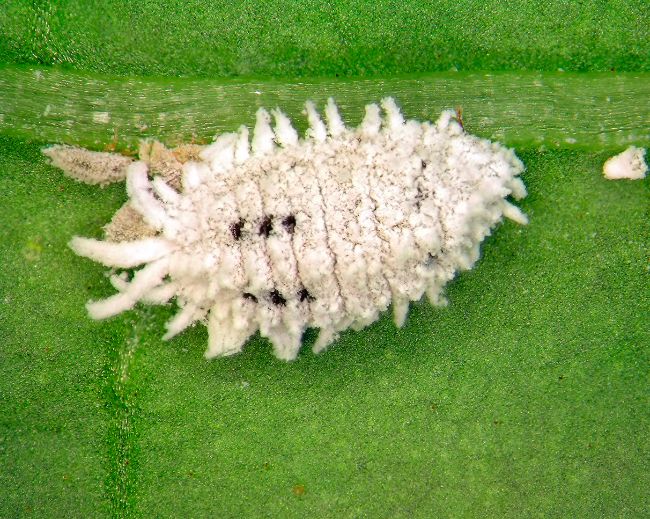
Mealybugs are pink, soft-bodied insects that are normally covered with white, cottony-like material. Their white, cottony coating protects them from drying out due to low humidity or excess heat, but it makes it very easy to detect them on your houseplants.
Mealybugs are more likely to be found in groups than individually, and prefer protected areas of the plant such as where the leaves attach to the stems.
Mealybug infestations can cause deformed or stunted leaf growth, particularly on new leaves, due to the damage caused by them feeding on the foliage. Mealybugs also produce honeydew, which can cause your plant to develop sooty mold.
Scale
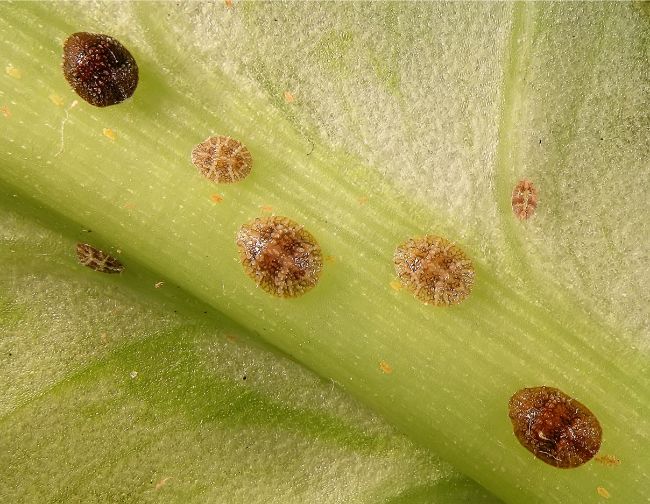
Scale can be found on a wide range of houseplants, as well as other shade and fruit trees. Scale insects that attack houseplants come in two different varieties: soft and armored scale. They both look like small brown lumps on the foliage, with soft scale being the more common of the two.
As the names suggest, soft scale lack a hard coating, having a powdery, waxy, cotton-like coating for protection instead. Armored scale have a hard shield-like layer, formed from shed skins and wax. This protects them against natural predators and chemical insecticides.
Scale insects pierce foliage, stems and branches to feed on the sap within these plant tissues. The plant can develops symptoms of damage as a result of this.
Leaf drop and generalised leaf yellowing are common symptoms caused by a scale insect infestation on your houseplants. You may also see yellow spots on the leaves, as well as wilting, stunted growth and generalised decreased vigor. To tell the difference in types of scale look for honeydew secretions; soft scale secretes a large amount of honeydew, the armored scale does not.
Thrips
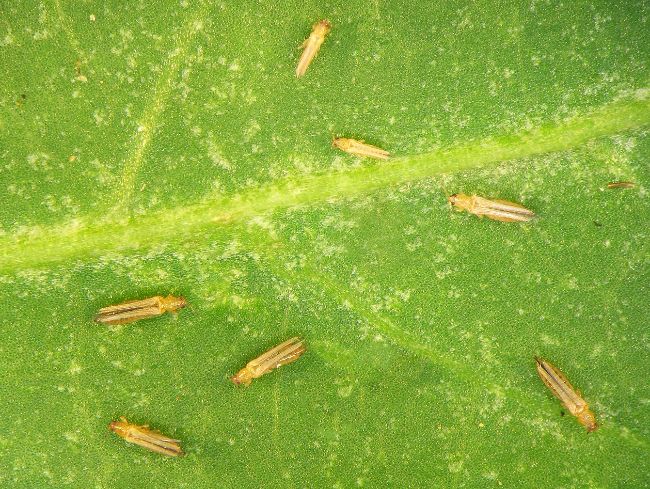
Thrips are minuscule (rarely more than 1/16 of an inch in length), slender insects with fringed wings. They also feed on the sap of indoor plants. Plant injuries appear as splotchy patches on leaves that over time turn pale, progress to a silvery color, and then die. Worse than the damaged tissue is the plant viruses that are commonly spread when thrips feed.
Whitefly
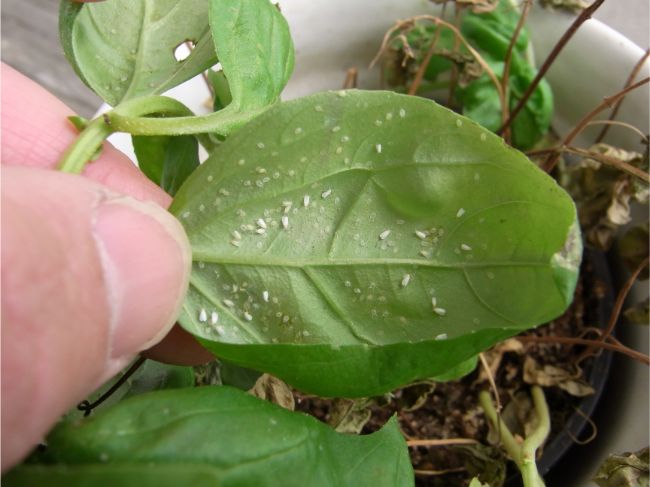
Whitefly is closely related to scale and aphids and is often mistaken for tiny white moths or even mealybugs. Insects are usually pale in color, almost translucent, and are covered with a powdery whitish wax.
When the host plant is disturbed they quickly take to flight making them hard to treat. Both nymphs and adults are sap-suckers and exude honeydew. Infestation symptoms include stunting, yellowing of leaves, and leaf drop.
The Best and Worst Plants For Bugs
Some plants are naturally better at repelling bugs, while there are some species that have a predisposition for problems.
Best Indoor Plants That Resist Pests
Plants known to repel bugs or have fewer insect problems are usually scented or have a waxy cuticle that prevents insects from piercing the leaves.
- Snake plant
- Chinese Evergreen
- Bromeliads
- Airplants
- Cast Iron Plant
- Grape Ivy
- Coleus
- Dracaena
- Mosquito Plant
- Catnip
- Jade Plant
- Venus Flytrap
- Herbs (basil, chives, chamomile, lavender, and mint)
Worst Indoor Plants For Bugs
It’s hard to really name specific plants that are more prone to bugs than other species. Indoor plants that do better in high humidity conditions or like a lot of water will definitely attract more bugs than the ones mentioned above.
Some high humidity lovers that can attract bugs:
- Ferns
- Peace Lily
- Calatheas
Tips on Prevention & Minimizing Damage From Houseplant Bugs
One of the best ways to deal with bugs in your plants is to prevent them from taking up residence in your home. The following tips can help you prevent and minimize damage from bugs.
- Carefully inspect new plants before bringing them into your home. Nurseries, where many plants are grouped together in humid environments, are more prone to bugs. Checking a new one before adding it to your collection can save you a headache down the road.
- Maintain some space and good airflow between your houseplants. Group them in an arrangement together but allow a few inches of space between containers or the plants’ foliage.
- Remove dead or diseased tissue/leaves from plants as soon as you notice them. This includes anything that drops from the plant and falls down to the surface of the potting soil. Soil debris is an inviting space for bugs.
- Inspect your plants for insects if you move plants outside and then bring them back inside your home. There are more bugs outdoors and they will try to freeload their way inside if they can.
- Routinely check your plants over to look for bugs. Early detection usually means less damage and the infestation is easier to treat. Make it a habit to visually inspect your indoor plants every time you water.
- When repotting container plants avoid the temptation to use old potting soil, especially if the package was previously opened and allow to sit in a garage or shed. It may contain eggs from insects.
- When insects are found, quarantine your plant from any others by moving it to another space. This may prevent infecting neighboring containers. Then treat quickly using the most appropriate method. See this article which outlines some of the best natural methods of getting rid of houseplant bugs.

